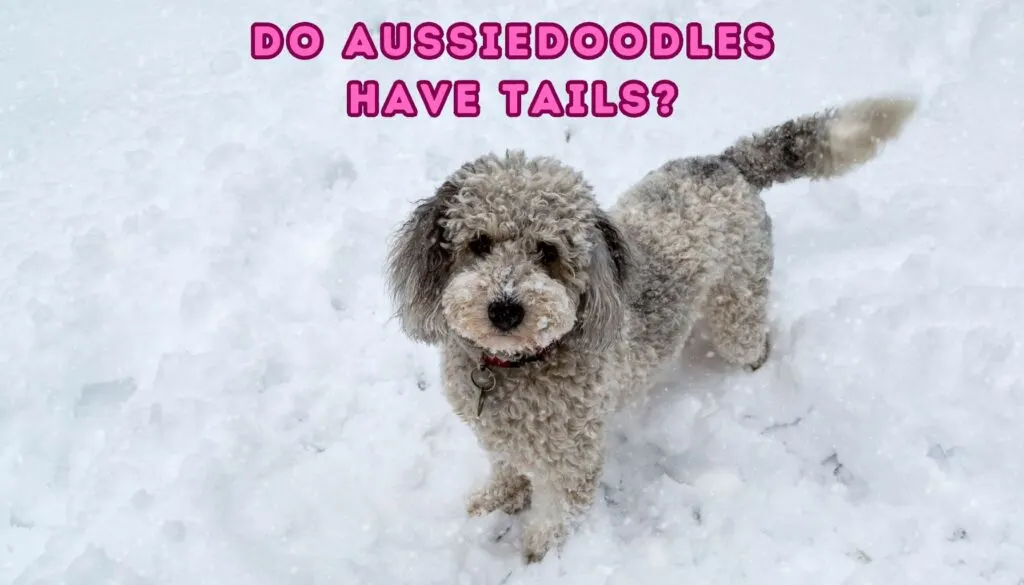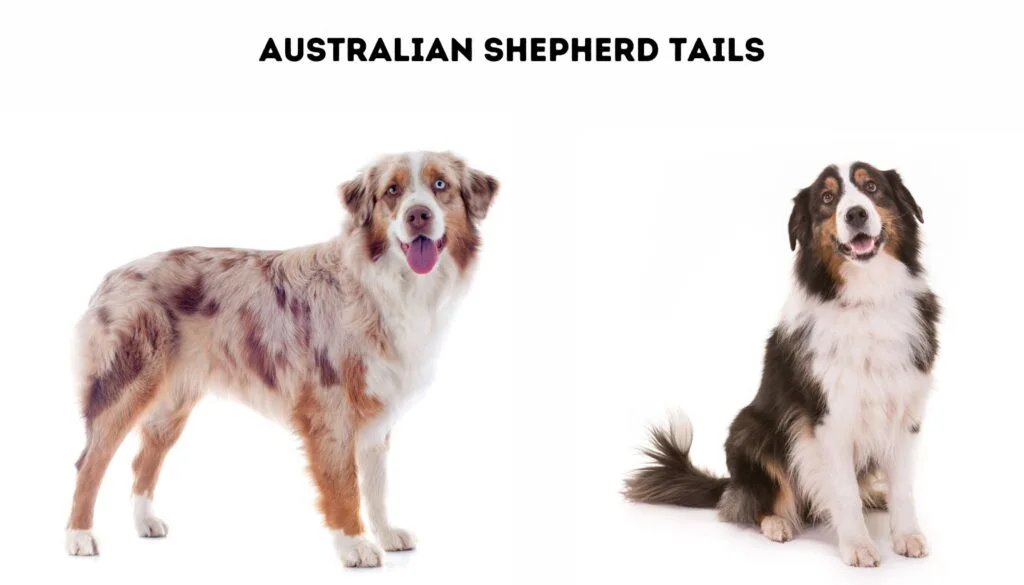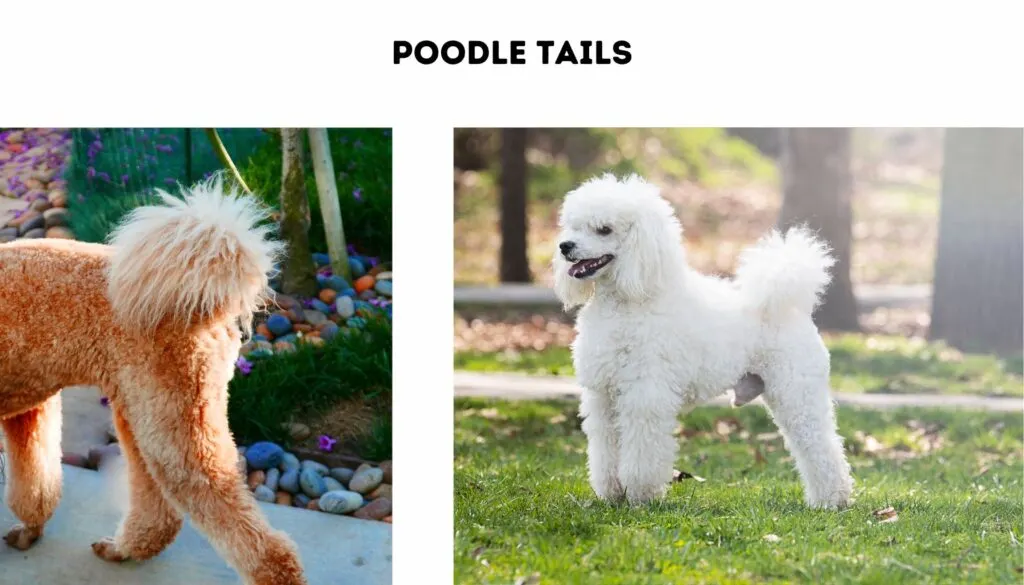Aussiedoodles, the delightful crossbreed that combines the intelligence and charm of the Australian Shepherd with the elegance and mostly hypoallergenic coat of the Poodle, are increasingly popular among dog lovers. One common question from potential owners: Do Aussiedoodles have tails? Like many aspects of this beautiful crossbreed, the answer isn’t always a simple yes or no!

Aussiedoodles may or may not have tails due to two factors: genetics and tail docking. Let’s look at the background of both and the controversy about this topic.
Genetics Play a Role
Australian Shepherds are known for their variability in tail length, with some naturally born with a bobtail.

The length of a dog’s tail is primarily controlled by the T-box gene, specifically a mutation in the T-box transcription factor T gene (T gene). This gene plays a crucial role in the development of the tail during embryonic growth.
This genetic trait is notably present in some dog breeds like the Australian Shepherd and others that are naturally born with short or “bobbed” tails. The inheritance of this trait is autosomal dominant, meaning that only one copy of the mutated gene is required for the trait to be expressed in the dog’s phenotype.

On the other side of the family tree, Poodles typically are born with a long tail. The AKC breed standard for the Poodle states, “Tail straight, set on high and carried up, docked of sufficient length to insure a balanced outline. Major fault: set low, curled, or carried over the back.”
The Aussiedoodle Tail
The genetics of Aussiedoodles can lead to a variety of tail types, influenced by both Australian Shepherd and Poodle traits.
The length and shape of their tails can vary significantly, with some inheriting the natural bobtail gene from the Australian Shepherd side.
The Sad Tale of Tail Docking
If Aussiedoodles are born with tails, they may still have significantly shorter tails upon adoption due to tail docking. Tail docking, the practice of removing part of a dog’s tail, is a controversial topic of much debate. The American Veterinary Medical Association (AVMA) has noted that it is a painful procedure for puppies, and “Painful procedures conducted in the neonatal period when the nervous system is vulnerable can result in negative long-term changes which affect how pain is processed and perceived later in life”
In Aussiedoodles, tail docking is less common than in purebred Australian Shepherds but is performed by some but not most breeders.
An increasing number of countries including the UK and Australia are prohibiting the docking of tails due to animal welfare concerns except in the cases of injury or health-related procedure.
The Role of Tails in Health and Communication
Along with pain and discomfort associated with the docking, the removal of a dog’s tail handicaps the dog in several ways. A dog’s tail is crucial for communication and body language. It can also play a role in balance and mobility.
For Aussiedoodles, having a full tail or a docked one can influence these aspects to varying degrees. Although most dogs learn to compensate for its loss over time, this is an especially important consideration if you are considering competing in agility with your dog.
Docking a dog’s tail can also have a significant impact on their ability to communicate, both with other dogs and with humans. Aussiedoodles use their tails as a key component of their body language, so altering the tail can affect this mode of communication.
Here’s how a docked tail might impact a dog’s ability to communicate:
Reduced Communication Signals: A dog’s tail is a crucial tool for expressing emotions and intentions. Wagging, for instance, can indicate happiness or excitement, while a tucked tail might show fear or submission. A docked tail limits this range of expression, making it harder for the dog to convey feelings clearly.
Impaired Social Interactions with Other Dogs: Dogs use tail positions and movements as part of their social language when interacting with each other. A docked tail can hinder this communication, potentially leading to misunderstandings or conflicts with other dogs who misinterpret the docked tail’s signals.
Difficulty in Expressing Alertness or Curiosity: Dogs often raise their tails when they are alert or curious. A docked tail might not be as visible or expressive, which can obscure these signals.
Challenges in Human-Dog Communication: Humans also read dog tails as part of understanding a dog’s mood or intention. A docked tail may make it harder for owners and others to read the dog’s signals accurately, which can affect training, bonding, and even safety.
Potential Increase in Aggression or Fear: Some studies suggest that dogs with docked tails might be more prone to aggression or fearfulness due to their inability to communicate effectively. This could be due to miscommunication with other dogs or increased anxiety from being unable to express themselves properly.
Grooming and Care
Regardless of length, an Aussiedoodle’s tail requires proper grooming to maintain hygiene and prevent matting, especially if it inherits the Poodle’s curly coat.
Regular checks for fleas, ticks, and signs of infection are also essential. Tail health should be a part of regular veterinary check-ups.
Whether an Aussiedoodle has a long, curly tail like a Poodle, a short bobtail like an Australian Shepherd, or something in between, each tail is unique to the individual dog. Understanding and appreciating these differences, along with responsible grooming and care, will ensure that your dog leads a happy, healthy life.
More Aussiedoodle Questions
Do Aussiedoodles Have a Double Coat or Single Coat?
Are Aussiedoodles Loyal to One Person?
Pin it to remember

- Free Printable Aussiedoodle Coloring Pages - January 30, 2024
- Aussiedoodle vs. Labradoodle: Which is Right for You? - January 29, 2024
- Are Aussiedoodles Barkers? - January 7, 2024
